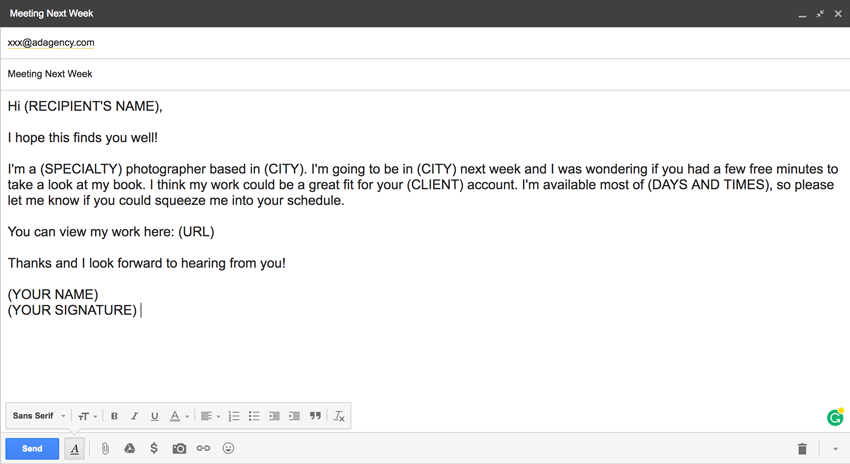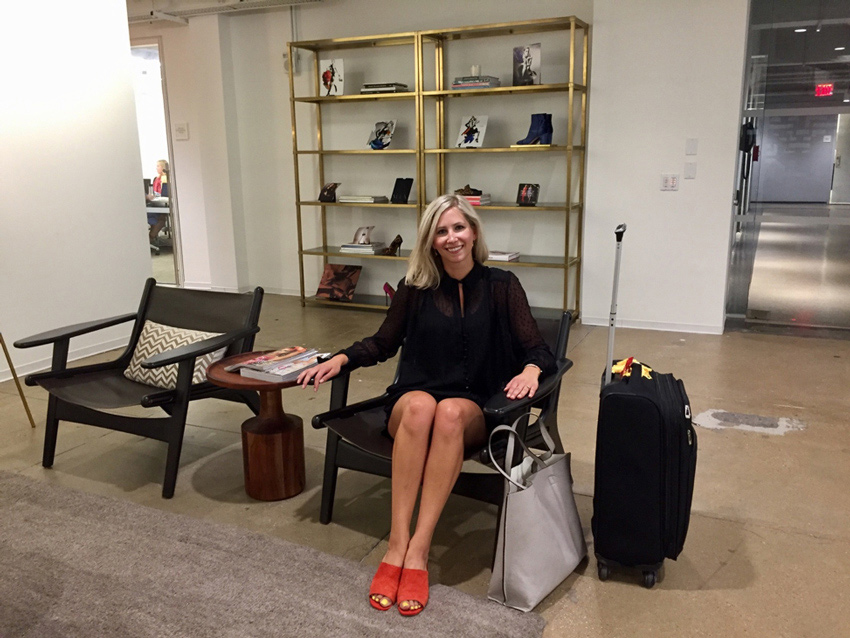Erika Blatt, Wonderful Machine
One-on-one portfolio reviews should be an essential part of any photographer’s marketing plan. It’s an excellent opportunity to get your work literally under the noses of decision makers at ad agencies, publications, and brands. We’ve found that creatives are more likely to work with photographers they know, and meetings are a great way to solidify those relationships. It’s your opportunity to present your brand, your work, and yourself. However, many photographers find the idea of setting up meetings to be somewhat daunting, so I’ve put together a step-by-step guide to securing and preparing for your portfolio reviews.
PREPARING YOUR PROMOTIONAL MATERIALS
Before even setting up a meeting, your promotional materials need to be in order and ready to go.
- First things first, make sure your website is up-to-date and fully functional. Nobody is going to make an appointment with you without first checking out your site. Make sure it’s solid (see our Expert Advice: Website Dos and Don’ts).
- Make sure your book is up-to-date and well-edited. Get a second opinion on your edit from a friend or a consultant (see our Expert Advice: How to Edit Photographs).
- Consider whether an iPad portfolio is appropriate for you. Print portfolios still get more attention from clients at our portfolio events than iPads do. But tablets are essential if you shoot motion, and they’re also a nice supplement to show recent projects or to go into greater depths on a particular subject.
- Have an appropriate leave-behind ready to go. A simple postcard can work. However, you’ll score extra points for something unique like a small booklet or even an app (like Tony Burns’ Shooting The World). Whenever possible, your leave-behind should be memorable, inventive, and reflective of your brand.
RESEARCH YOUR PROSPECTS
Whether you’re traveling across the country, or just across town, take the time to do some research and make sure you’re barking up the right trees. Check out each client’s website to make sure that your photography matches up with their needs, so you don’t waste your time or theirs. Start close to home and then branch out from there. You will only be able to meet with a relatively small number of prospects over the course of your career, so make each appointment count.
As useful as list services are, nothing is more valuable than personal networking. When you find one client who responds to your work, ask them if they know any others who might be a good match for you. As you start to cultivate relationships with prospective clients, it will be essential to keep good records of your interactions with them.
REQUESTING & PLANNING FOR MEETINGS
After you’ve compiled your list of prospects that you want to meet with, the next step is to start reaching out. We’ve found that contacting people roughly a week before you’d like to meet is a good rule of thumb. Do it too far in advance, and you risk having them forget about the meeting or canceling on you. Too little notice may find them already booked up. Start with a casual email that includes the following:
- The prospect’s name
- A little about how your skills and interests might match up with their needs
- A link to your site
- The dates and times you’re available
There are a few tricks you can use that can help you get noticed:
- Don’t attach images to your email. I find that this increases the chance of your email getting stuck in spam filters. But it doesn’t hurt to attach a JPEG to your follow-up email.
- Give the impression that you’re going to be in town for other meetings (even if you haven’t set up any others yet). You don’t want anyone to feel the pressure that you’re making a special trip for them.
- Don’t ask for too much time. “A few minutes” is what you should ask for. If you get more than that, then great! Here’s a basic template you can follow:

A couple of days later, if you haven’t heard back from them, follow up with a phone call. Keep the call short and sweet:
Hi, this is XXX, I’m a type of photographer based in city. I sent you an email a few days ago about meeting with you for a few minutes to hear about your creative needs and if there’s a way my style would fit in.
Sometimes it’s helpful to write out a script and practice it, so you’re comfortable with what you’re going to say. You might have to practice it a few times, so you don’t sound like a robot. Creating a succinct message that you can deliver in a relaxed way will give you the best chance of success. Creating an alternate script for voicemails is a good idea too.
Similar to the email, only ask if they have a few minutes to take a look at your book. If they don’t answer, or don’t get back to you, you can try sending one last email. But don’t get hung up on this one client, just move on to the next. Remember, the more people you reach out to for meetings, the more likely someone will have some interest or time available.
Once you start booking meetings, make sure you give yourself enough time for each meeting plus travel time to get to the next one. If you’re going to New York, try to book as many meetings as possible within walking distance so you can maximize your time. If you have to drive from one meeting to the next, account for the time it takes to get your car out of the parking garage and then find parking at the next place. Give yourself enough time for meetings to run long.
Build an itinerary for yourself including time of meetings, contact’s name, phone number, email address, physical address. Plan ahead how you’ll be getting around. (By the way, TripIt is a great (free) app for keeping track of meetings.)
THE MEETINGS
Now that you’ve booked your meetings, time to do some additional research on the clients. One-on-one portfolio meetings are usually with one or two other people and quite casual, lasting less than 20 minutes. Check out their LinkedIn, Instagram, and social media sites in addition to their website. You’ll want to demonstrate that you know their business and you’ll have enough to talk about. If you’re meeting with an agency because you think you’d be a great fit for their client, make sure they still have that client. See if there are any similarities between the two of you, it’s nice to have those candid moments during the meeting that show your interest and preparation. Plus, the client will feel more at ease. If it’s in the morning, it can be a nice touch to pick up a couple of extra coffees to bring along to the meeting.
Make sure you’re dressed for the occasion. While most ad agencies have casual dress codes and work environments, that doesn’t mean you should show up for a meeting in a hoodie. Dress the part of someone that could command a high-value shoot.

Once you’ve arrived at your meeting, it’s time to turn on the charm! Be relaxed, but energetic. I’d start with your elevator pitch and then walk them through your portfolio, explaining your creative process, and then offer up interesting stories or details about your experience on that shoot when you see them lingering on a certain image. You’ll find that some clients are expressive and chatty when looking through your book, while others like to flip through the pages quietly. You’ll have to gauge yourself whether or not they feel like talking while they look at your work.
Don’t ask clients to critique your photography or your presentation. That’s not their job, and it will make you seem like an amateur. Just guide them through your work and express an interest in their projects. Show that you’re interested in what they’re doing, but no hard sell. They may ask you about any personal projects you’re working on … sometimes to see if you are an inspired photographer with your own ideas or sometimes to see if it’s something they’d be interested in seeing.
Don’t expect to get an assignment on the spot and don’t be upset if you feel like you didn’t get the praise you were hoping for! The purpose of these meetings is for creatives/photo editors to get to know you and hopefully build up a comfort level so they will ask you for a bid when an appropriate project comes up.
Be sure to take your print book (obviously!), your print promo or leave-behind, as well as business cards. Again, if you shoot motion, it’s a must to bring an iPad or tablet.
FOLLOW UP
A few days later, send a hand-written thank-you note. Keep it short and sweet, just to thank them for the meeting. If you have any additional promos or branded garb (t-shirts, mugs, notebooks, etc.) now’s a good time to send that as well.
From there, an occasional email or print promo update is appropriate (every few months), especially if you have some news to share. It’s also smart to connect on LinkedIn so you can keep track of their career path. Creative departments are continually evolving and switching accounts, or following accounts to different agencies – you never know when a good prospect moves to a new company that would be perfect for your photography. Plus, it helps you to stay on their radar.
If you need a hand building a client list or setting up meetings, please call us at 610.260.0200 or reach out. Or you can visit our consulting page to learn more.



2 Comments
Good information, especially for those who haven’t been through this process.
Thank you, Thank you!
Very helpful.
Comments are closed for this article!